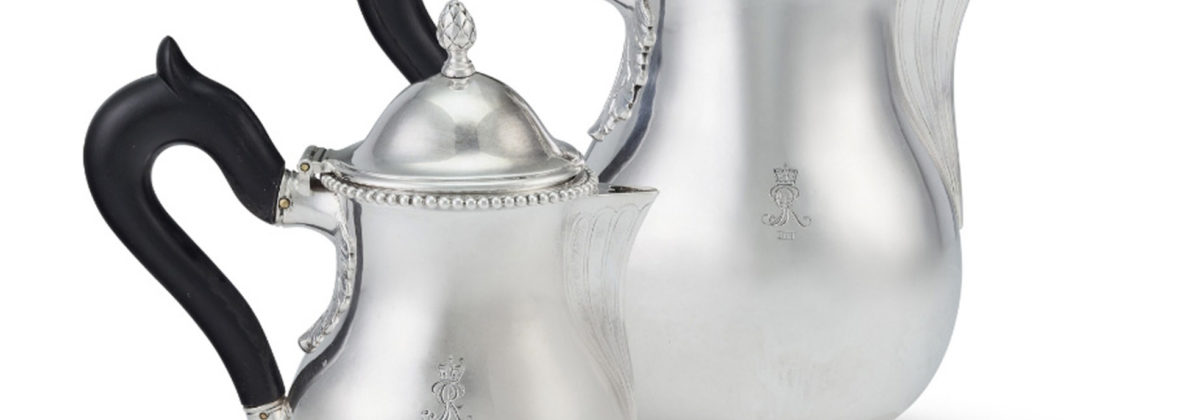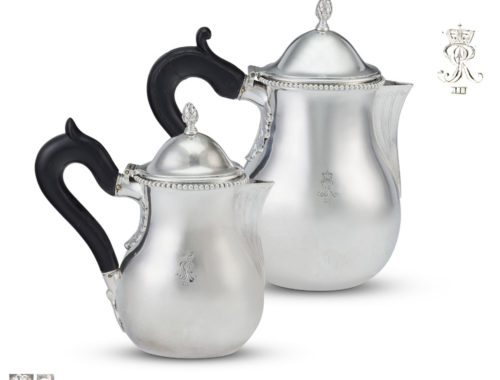Detailed Description
Detailed information
Thin baluster form with beaded upper rim and flat fluted spout, the hinged domed cover with bud finial, the ebonized loop handle terminating in acanthus, engraved on one side with the monogram of George III under a coronet, marked on underside
The silver of the Wettiner
The House of Wettin had always had a lot of treasures made in silver. Part of the raw material for the making of them came from the Harz region in Germany. In July 1768, George III. approved the melting down of around 126 kilos silver (tableware). Pieces of the silver collection that were not anymore in fashion were chosen for this large action of destruction. Around one third of the collection was melted down, initially not with the intention to make new, fashionable pieces of silver, but to use the money made from the material for social purposes.
In 1770, there was however the intention to make a new silver service that would be made according to the fashionable style of the eighteenth century. Overall, it can be assumed that the service was initially planned for 60 to 72 persons, while it was decided it to produce it in 15-lots silver (i.e. 937,5/1000 silver, which would correspond to the English standard of 925/1000 silver).
Franz Peter Bunsen, goldsmith of the court, had been chosen with the approval of the monarch for the making of this new royal service. The duration for the making of the pieces was initially calculated at almost 4 years. From the survived documents, it appears that George III – who had never visited Hanover – was implicated in all the different phases of the making of the service. He put a lot of importance on the making of a “service à la française”, which was the latest kind of official dining in the eighteenth century.
For this reason, it has been after all decided to place the commission for such a service to a French maker. Robert Joseph Auguste (1723-c. 1805) delivered a great number of it, however Franz Peter Bunsen had been working on the service as well, to make additions of needed pieces. The whole service was ready in 1790, while during the next years, there have been some additions.
In 1841, the cypher of George III has been retrospectively added to this so called “A” service. This was the decision of the son of George III, Ernest Augustus (1771-1851), King of Hanover since 1837, who also lived in Hanover. 2.226 pieces of this service have been adorned with the cypher of George III by Johann Carl Matthias.
With the accession of the House of Hanover in 1714, British monarchs tended to use royal cyphers as a personal and royal symbol, rather than the royal badges, which were until then into use. Royal cyphers are practical the monogram of the monarch, accompanied by the crown. Royal badges alluded to a specific person, but they could be also borne by others who wanted to show a kind of livery badge. These were often flowers or other symbols (like e.g. stars).
Master: Johann Georg Eckhardt, born 1736, master: 1767, head of the office since 1803, died 1814
Lit:
Seelig, Lorenz, ‘Das Silberservice König Georgs III. Von Robert-Joseph Auguste und Frantz Peter Bundsen. Zur Goldschmiedekunst des frühen Klassizismus in Paris, London und Hannover’, In: Münchner Jahrbuch der Bildenden Kunst, 3. Folge, Bd. LVIII, Munich: Staatliche Kunstsammlungen & Zentralinstitut für Kunstgeschichte, 2007, p. 141-207.
Scheffler, Scheffler, W., 1965, Goldschmiede Niedersachsens: Daten – Werke – Zeichen, 2. Halbband, Aerzen-Hamburg, Berlin: De Gruyter.
Waldemar R. Röhrbein: Bunsen, Peter Franz. In: Hannoversches Biographisches Lexikon. Schlütersche Verlagsgesellschaft, Hannover 2002, p. 79.



